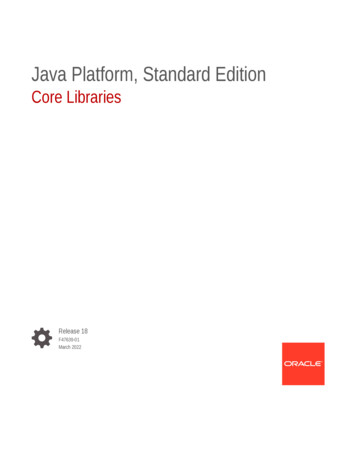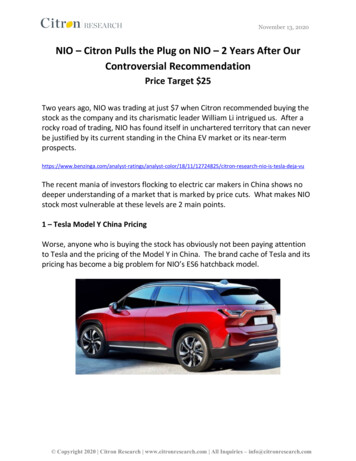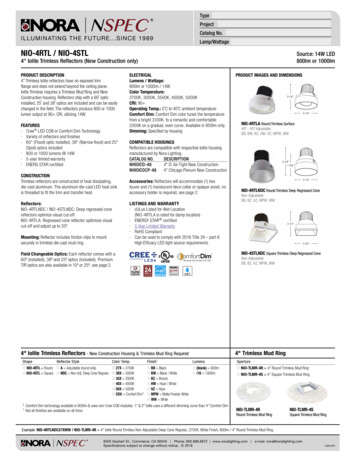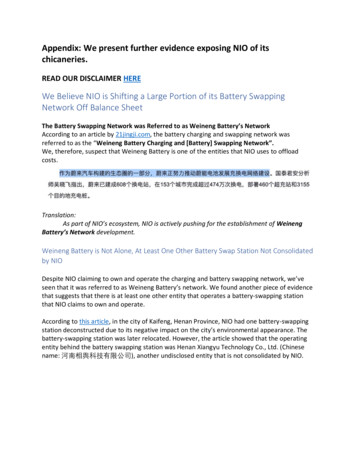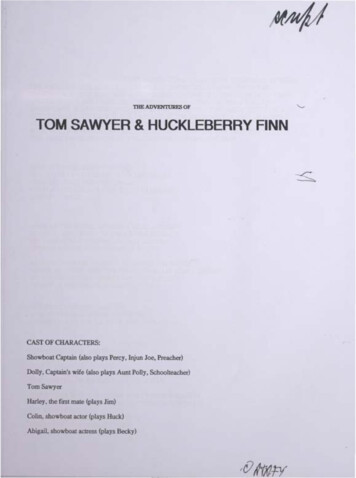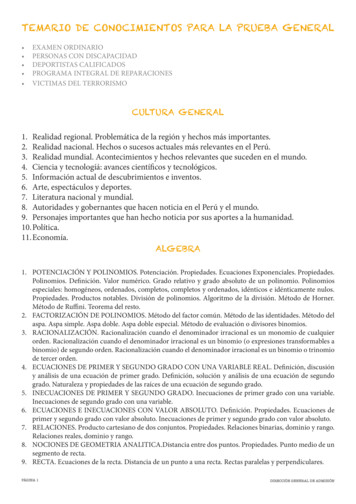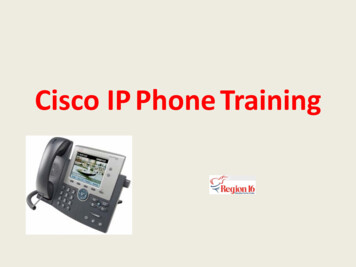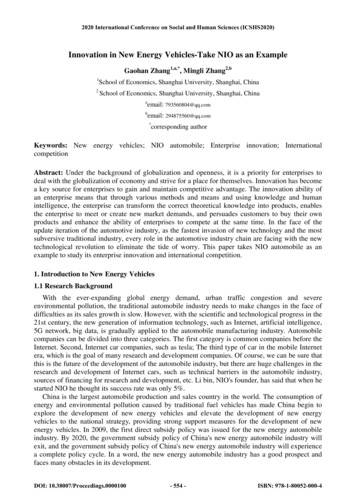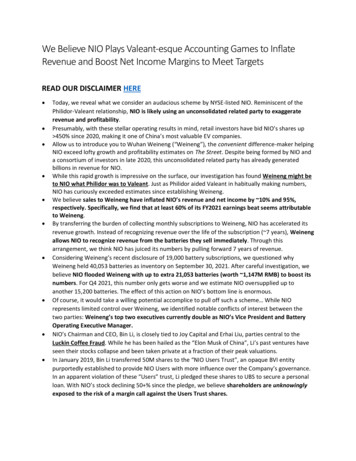
Transcription
We Believe NIO Plays Valeant-esque Accounting Games to InflateRevenue and Boost Net Income Margins to Meet TargetsREAD OUR DISCLAIMER HERE Today, we reveal what we consider an audacious scheme by NYSE-listed NIO. Reminiscent of thePhilidor-Valeant relationship, NIO is likely using an unconsolidated related party to exaggeraterevenue and profitability.Presumably, with these stellar operating results in mind, retail investors have bid NIO’s shares up 450% since 2020, making it one of China’s most valuable EV companies.Allow us to introduce you to Wuhan Weineng (“Weineng”), the convenient difference-maker helpingNIO exceed lofty growth and profitability estimates on The Street. Despite being formed by NIO anda consortium of investors in late 2020, this unconsolidated related party has already generatedbillions in revenue for NIO.While this rapid growth is impressive on the surface, our investigation has found Weineng might beto NIO what Philidor was to Valeant. Just as Philidor aided Valeant in habitually making numbers,NIO has curiously exceeded estimates since establishing Weineng.We believe sales to Weineng have inflated NIO’s revenue and net income by 10% and 95%,respectively. Specifically, we find that at least 60% of its FY2021 earnings beat seems attributableto Weineng.By transferring the burden of collecting monthly subscriptions to Weineng, NIO has accelerated itsrevenue growth. Instead of recognizing revenue over the life of the subscription ( 7 years), Weinengallows NIO to recognize revenue from the batteries they sell immediately. Through thisarrangement, we think NIO has juiced its numbers by pulling forward 7 years of revenue.Considering Weineng’s recent disclosure of 19,000 battery subscriptions, we questioned whyWeineng held 40,053 batteries as inventory on September 30, 2021. After careful investigation, webelieve NIO flooded Weineng with up to extra 21,053 batteries (worth 1,147M RMB) to boost itsnumbers. For Q4 2021, this number only gets worse and we estimate NIO oversupplied up toanother 15,200 batteries. The effect of this action on NIO’s bottom line is enormous.Of course, it would take a willing potential accomplice to pull off such a scheme While NIOrepresents limited control over Weineng, we identified notable conflicts of interest between thetwo parties: Weineng’s top two executives currently double as NIO’s Vice President and BatteryOperating Executive Manager.NIO’s Chairman and CEO, Bin Li, is closely tied to Joy Capital and Erhai Liu, parties central to theLuckin Coffee Fraud. While he has been hailed as the “Elon Musk of China”, Li’s past ventures haveseen their stocks collapse and been taken private at a fraction of their peak valuations.In January 2019, Bin Li transferred 50M shares to the “NIO Users Trust”, an opaque BVI entitypurportedly established to provide NIO Users with more influence over the Company’s governance.In an apparent violation of these “Users” trust, Li pledged these shares to UBS to secure a personalloan. With NIO’s stock declining 50 % since the pledge, we believe shareholders are unknowinglyexposed to the risk of a margin call against the Users Trust shares.
Chinese government entities have redeemed US 2B from NIO and may collect another US 6.7B.With NIO’s cash balance of just US 8.2B. We believe shareholders risk being materially diluted infuture periods.IntroductionNIO went public in September 2018 and has been touted as one of the most disruptive EVcompanies in China.Two of NIO’s key differentiators have been its investments in its Battery Swap System andBattery as a Service (BaaS) segments. These investments have garnered tremendous hypeamong investors and EV enthusiasts as NIO is the only major Chinese EV company funding suchinitiatives, setting it apart from competitors. As of June 2022, NIO had completed over 7.6million battery swaps and deployed over 981 battery swap stations, with this number slated togrow to 1,300 stations by the end of 2022.We have discovered that NIO has used Wuhan Weineng, an unconsolidated related partyentity, to inflate its revenues and boost margins. By selling batteries far in excess of Weineng’srequirements, we estimate NIO’s net loss should be 95% higher for the 9 months endedSeptember 2021.Our research also revealed hidden and opaque share agreements which benefit the Chinesegovernment at the expense of public shareholders, as well as previous affiliations and failedventures of NIO’s CEO, Bin Li.This scheme reminds us of a certain high-flying pharmaceutical company that took Wall Streetby storm before eventually being exposed for using related parties to manipulate its financials.
NIO’s Philidor Moment: NIO is Pulling Forward Revenue andManipulating Costs to Boost MarginsNIO has been using an unconsolidated, related party subsidiary to engineer its financials andconsistently beat Wall Street targets in a scheme reminiscent of that which was used betweenValeant and Philidor. For the nine months ended September 2021, NIO has inflated its revenueand net income by 10% and 95%, respectively.Source: Grizzly ResearchIn August 2020, Wuhan Weineng Battery Asset Co. Ltd (“Weineng Battery” thereafter, Chinesename: 武汉蔚能电池资产有限公司) was formed by NIO and a consortium of governmententities and private investors like CATL. NIO holds a 19.8% stake in Weineng and accounts forthe company using the equity method of accounting:“In August 2020, the Group and three other third-party investors jointly established theBattery Asset Company. The Group invested RMB200,000 in the Battery Asset Companyand held 25% of the Battery Asset Company’s equity interests. In December 2020, theBattery Asset Company entered into an agreement with the other third-party investorsfor a total additional investment of RMB640,000 by those investors. In 2021, the Groupfurther invested RMB270,000 in the Battery Asset Company and upon the consummationof the investment, the Group owns approximately 19.8% equity interests of the BatteryAsset Company. The Group, as a major shareholder of the Battery Asset Company, isentitled to appoint one out of nine directors in the Battery Asset Company’s board ofdirectors and can exercise significant influence over the Battery Asset Company.
Therefore, the investment in the Battery Asset Company is accounted for using theequity method of accounting.”Since Q4 2020, NIO has surprised net income expectations by an average of 33% while beatingtop-line estimates by an average of 5%. For FY2021 the Street expected NIO to lose 5,947million. Instead, NIO posted a net loss of 3,007 million RMB, an amount that was 50% higherthan expectations(a difference of 2,940 million RMB). Due to a lack of regularity in Weineng’sfinancial reporting, we can only infer the true effect of the financial engineering between thetwo companies for the 9 months ended September 2021. From these figures, however, we cansee Weineng was crucial to this upside surprise in earnings.Battery SwappingNIO owns and operates battery swapping stations across China where its vehicle owners canexchange their batteries for new and fully-charged battery packs in just a few minutes. Thisinitiative has historically had mixed results because of its flawed economics.In 2008, a start-up called Better Place launched the initiative in Israel. After spending 850M oncapital expenditures, Better Place filed for bankruptcy in 2013. Tesla presented a similar idea in2013 but completely abandoned the plan due to marketing, technical and financial reasons.Despite this history, NIO has mysteriously taken a misfit business and transformed it into apromising one and a key factor in investors’ bull case. Since Q4 2020, the company has quicklyscaled from just 172 stations to over 981 stations. What is NIO’s secret sauce?Battery as a Service (BaaS)Building upon its Battery Swapping business, NIO introduced “Battery-as-a-Service” to givecustomers the option to purchase a car without the battery. This structure lowers the totalprice of the car by at least 70,000 RMB and is supposed to improve EV adoption. Through theprogram, users can then lease the battery from the BaaS provider, paying 980 RMB-1,480 RMBper month or 11,760 RMB-17,680 RMB annually, depending on the capacity of the batteriesrented.Below are screenshots from the NIO app which show the reduction in the upfront price andsubscription pricing when users opt to rent using BaaS. Our conversation with the salespersonin NIO’s EV center also confirmed these two monthly rental prices under the 70/75kWh batteryand 100kWh battery selection, respectively.
Source: NIO AppGiven the synergies between Battery Swapping and BaaS, we were puzzled to see NIO spin offthe BaaS business as an unconsolidated entity where they have to share economics with otherinvestors. However, after a deeper investigation, the answer appears clear. NIO spun-offWuhan Weineng to help artificially boost its battery swapping business and overallperformance.According to NIO’s filings, Weineng is the entity that owns the batteries used in the BaaSbusiness and is responsible for managing the subscriptions. Thus, when a user subscribes to theBaaS program, Weineng is the recipient of all subscription payments. Where does Weineng getthe batteries it provides? None other than NIO “Under the BaaS, we sell a battery to Wuhan Weineng Battery Asset Co., Ltd., or theBattery Asset Company, and the user subscribes for the usage of the battery from theBattery Asset Company.“Since Weineng Battery was formed in August 2020, NIO has found it to be a reliable andgrowing stream of revenue. In just four months of operating in 2020, NIO generated 290 millionRMB from sales to Weineng. Despite this quick start, revenue attributable to the entityballooned even further in 2021 to 4.14 billion RMB representing 11% of overall 2021 revenue.The arrangement between Weineng and NIO has helped them in three ways:1) Pulling forward several years of revenue to help meet ambitious estimates2) Providing a willing counterparty to sell more batteries than their required network needs3) Shifting depreciation costs off their financial statements
Never Stop Pulling: How NIO is Pulling Forward Future Revenues Using Wuhan WeinengIf Weineng did not exist, NIO would have to recognize subscription revenue from customersover the lifetime of their subscription. Luckily for NIO, they don’t have to wait Consider a 70KRMB sale. Normally it would take NIO approximately 7 years (inflation-adjusted) to generatethe full subscription revenue, but with Weineng, they can recognize the revenue immediately.In other words, NIO can pull forward approximately 7 years of recurring revenue andrecognize it immediately to artificially boost revenue growth without incurring any additionalcosts.We were able to retrieve Weineng Battery’s prospectus for an Asset-Backed Financing whichrevealed key information about its subscriptions. As of September 30, 2021, 19,000 users areserviced under the BaaS service agreement, 18% of which are subscribed to the 100kWhbattery BaaS service and 82% to the 70-75kWh battery.Source: Weineng’s ABN ProspectusUsing these numbers, we can determine what NIO’s financials would look like if Weineng didnot exist. Contrary to the 2,796 million RMB in revenue reported, NIO would have receivedroughly 19.84 million RMB per month, or approximately 179 million RMB for the 9 monthsending 2021 ( 239 million RMB annualized for 2021).Although Weineng never filed any updates to their 2021 Q3 numbers, the analysis in this reportis still very relevant and valid. As of today, NIO is still offering BaaS to its consumers, andWeineng continues to operate as an unconsolidated entity.Below is a screenshot of NIO’s current offering.
Buy Vehicle with BaaS.Source: NIOThrough the Weineng scheme, NIO has pulled forward over 1.147 billion RMB in revenueresulting in an equal improvement in reported earnings. We estimate NIO’s true net incomefor the period to be a loss of 3.02 billion RMB.The following chart shows how we derived these figures, with a few conditions:1) As we will show, we believe only the 19,000 batteries corresponding to Weineng’s 19,000service users can be considered real sales. Instead, Weineng holds total batteries more thandouble this number. We will deal with these surplus batteries in the next section and showreaders why we believe NIO has been further inflating revenue by overselling batteries tothis counterparty.2) We define revenue that has been “pulled-forward” as any revenue beyond what NIO wouldhave received in the first year of subscriptions had it consolidated Weineng as a subsidiary.3) NIO has grown the top-line absent the incremental costs that would be associated withreal revenue. This is because regardless of the arrangement, NIO would have paid andbought batteries to operate its BaaS business. Thus these financial costs are already bakedinto NIO’s financials.
Source: company filings, Grizzly analysisThe arrangement with Weineng helped NIO inflate its revenue for 9 months ending September2021 by almost 4%. which directly flowed into its bottom line; NIO’s adjusted net loss shouldbe 61% larger than the reported figure.In the next section, we show how NIO took advantage of this scheme to sell batteries in excessof what is required by the BaaS business and inflate revenue.How NIO has been Oversupplying Wuhan WeinengWe believe NIO intentionally oversupplied Weineng with batteries. By calculating the batteryrequirements of the BaaS network, we show the quantities supplied by NIO far exceedjustifiable amounts.According to the Weineng Battery’s ABN Prospectus, up to September 2021, Weineng had40,053 batteries.“截至 2020 年末及 2021 年 9 月末, 武汉蔚能 持有 BaaS 电池资产数量 分别为4,115 块和 40,053 �As of year-end 2020 and 9 months ending Sep 2021, Wuhan Weineng possesses 4,115and 40,053 batteries respectively. The operation is rapidly growing.”- Source: Weineng Battery ABN ProspectusRecall there were only 19,000 users who had subscribed to the BaaS program as of September30, 2021, implying an excess of 21,053 batteries. Assuming the same 20-80 mix between 75kwhand 100kwh batteries, we can deduce that inundating Weineng with batteries helped NIO
report 1.47 billion RMB in additional revenue and 294 million RMB in additional net income.The below chart shows the math behind this conclusion.One of the key assumptions embedded in our analysis is that the battery margins areapproximately 20%. We believe this is a conservative estimate as it is consistent with themargin of an entire vehicle and batteries are a cost center for all vehicles.Source: company filings, Grizzly analysisWhile we do not have inventory numbers from Weineng beyond September 2021, we can showthat NIO continued this scheme into Q4 2021. Dividing NIO’s Weineng sales of 2,796M RMBover 40,053 batteries gives us an average selling price of 70K RMB. We also know that forFY2021, NIO sold 4,138M RMB for the full year, implying revenue of 1,342M RMB for Q4 2021.Using our average selling price, this would imply that in Q4 2021, NIO sold another 19,000batteries to Weineng, further increasing its battery inventory by almost 50%.Bulls might argue Weineng purchased these excess batteries to smooth out operations but aswe are about to show:1) Weineng buys battery packs from NIO on a back-to-back, implying that battery sales shouldmatch subscriber numbers2) Low utilization at battery stations negates excess batteries needsNIO Battery Sales to Weineng Should Match Subscriber NumbersNIO states in its most recent 20-F that it sells batteries to Weineng on a back-to-back basis, atthe same time as when a NIO customer subscribes to BaaS and purchases their car without a
battery. NIO then recognizes the sale when the vehicle (together with a “subscriber battery”) isdelivered to the customer, at which point the control is transferred to Weineng.This implies that when a BaaS subscriber purchases a car, Weineng buys 1 batterycorresponding to this sale. After delivery of the car, this battery is “owned” by Weineng andbecomes a part of Weineng’s assets.Operationally, NIO does not differentiate Weineng batteries from NIO batteries at theirswapping stations. NIO does not restrict BaaS users to only Weineng-owned batteries whenthey come to swapping stations to perform battery swaps, nor do they restrict non-BaaS usersfrom only accessing NIO-owned batteries. The lack of such restrictions is important because itnullifies the need for NIO to sell excess batteries to Weineng for logistical reasons.We sent our investigator to visit a NIO car center, where he had a conversation with a NIOsalesman about BaaS. Our investigator also took a test drive and conducted a battery swap. Wediscovered that there is no distinction between BaaS and non-BaaS batteries. The onlydistinction the salesman made was that there are two types of batteries, that is short-rangebattery and the long-range battery. We were told by the salesman that users could swap forboth batteries if they want.Interview Transcript [paraphrased]Q (investigator): The long-range battery [BaaS Program] could not swap for a short-rangebattery?A: (NIO salesman): All the battery pack is the same size, and they are just different in terms ofenergy density.Q: So the short-range battery could also swap for a long-range battery.A: Right. Your short-range battery can also swap for a long-range battery.We further confirmed that there is no differentiation by looking through the NIO app. Forexample, the below screenshot shows a battery-swapping station in Beijing. After selecting thisswapping station, a user was not asked by the app if he/she is a BaaS subscriber or not. Itdirectly shows how many batteries are available in this station. In this case, it shows there are13 batteries in total and 13 batteries are available for swapping.The NIO app also shows more details of the available batteries. There are two choices for thebatteries, one is called a standard range (short-range) battery (70/75kWh) and a long-rangebattery (100kWh). If we click the battery section, it will show that this station has 8 short-rangebatteries and 5 long-range batteries. No differentiation of NIO battery vs Weineng battery, norBaaS battery vs Non-BaaS batteries were made.
Source: NIO AppSince BaaS users can tap into NIO’s network of batteries, regardless of whether they are ownedby Weineng, Weineng doesn’t have much of a need to maintain excess batteries. Thus thenumber of batteries owned by Weineng should correspond to the number of subscribers.However, as of September 30, 2021, Weineng had 19,000 subscribers under the agreement butheld 40,053 batteries in inventory.From both an operational and structural standpoint, Weineng has no need for any excessbatteries. Therefore this evidence leads us to believe that NIO has oversupplied Weineng by upto 21,053 batteries as of Q3 2021 to boost its financials.Site Visits and App Analysis Reflect Low Utilizations in Select LocationsFurthermore, our due diligence team observed some of the stations during the busiest hoursand saw little-to-no traffic. Our observation makes us believe that these battery swappingstations likely have very low utilization negating such expansive inventories.
Source: physical NIO battery-swapping stationsWe supplemented our physical diligence with an analysis of the NIO App. This analysis providedus with several data points such as batteries available and people in line. From these availablemetrics, we were able to calculate battery utilization.We observed 25 of these stations at 2-hour intervals and found NIO’s battery swapping stationshad a weighted average utilization of just 39%. Note that we deliberately avoided parts of Chinathat are under a very strict “COVID-Zero” policy (For example, Shanghai was completely shutdown and all stations had 0% utilization during our observation window. We did not choose toinclude that in our analysis). The low utilization further strengthens our belief that Weinengdoes not have a need for excess batteries at these stations, indicating that NIO likelyoversupplied Weineng by up to 21,053 batteries.Of course, when you purchase thousands of batteries, physical storage is required. To ouramazement, however, after searching for months we were unable to identify or locateWeineng’s storage facilities. Our team also consulted employees from numerous batteryswapping stations but we were not able to obtain any knowledge of where the batteries couldbe stored. Weineng’s prospectus also neglected disclosure on battery storage (i.e. 99% ofWeineng’s fixed assets are batteries). At best, this leads us to believe many of these excessbatteries remain in NIO storage facilities.Accounting Magic: Shifting Depreciation CostsAnother benefit of creating the Weineng Battery entity is that NIO can realize enormousdepreciation savings. According to NIO’s 2020 20F, the useful life of Charging & BatterySwapping Infrastructure and Equipment (including batteries) is 5 years. Strangely, NIO recentlychanged the useful life to 5-8 years, meaning batteries on the balance sheet depreciate by 15% per year.Recall NIO’s sales to Weineng for the 9 months ending September 2021 were 2.8 billion RMB.We believe almost all of these sales of goods are comprised of battery sales. Assuming 20%margins on this revenue, this would imply that NIO collectively shifted assets that cost 2.25billion RMB off their balance sheet for the period. This means that these batteries will save NIO
up to 336 million RMB for 9 months ending September 2021 in depreciation costs whichdirectly impacts (and inflates) the company’s bottom line.Coupled with the revenue inflation outlined in previous sections, we estimate Weineng Batteryalone can artificially improve NIO’s bottom line by over 3 billion RMB. As of the 9 monthsending September 2021, NIO’s reported a net loss of 1.874 billion RMB. Without all theseaccounting shenanigans, NIO’s net loss would nearly double to 3.690 billion RMB!Source: company filings, Grizzly analysisNot only is NIO able to recognize 2.6 billion RMB in additional revenues from the BaaS business(which would otherwise not exist if NIO consolidated it) but they are also able to shift costs andexpenses associated with the battery swapping business off-balance sheet. By doing so, NIO hasfooled Wall Street and investors with reported financial performance that is detached from thebusiness’ reality.
NIO Maintains Effective Control: Top Weineng Managers Are Current NIO ExecutivesWithin its 2021 20-F Risk Factors, NIO states that they have limited control over WeinengBattery.However, within the same filing, NIO states that:“The Group, as a major shareholder of the Battery Asset Company, is entitled to appointone out of nine directors in the Battery Asset Company’s board of directors and canexercise significant influence over the Battery Asset Company. Therefore, theinvestment in the Battery Asset Company is accounted for using the equity method ofaccounting”Based on this conflicting disclosure, NIO investors might be confused as to how much controlNIO actually has over Weineng. Executing the scheme we have detailed in this report wouldrequire NIO to exercise significant control over Weineng. Our research indicates that is exactlythe case.According to Qichacha, a well-known corporate due diligence platform, Weineng Battery’sChairman and legal representative, Fei Shen, and general manager and Director, Ronghua Lu,are both NIO employees.Source: QichachaWe believe these two individuals lead Weineng Battery’s daily operations and material businessdecisions licensing them to effectively exercise control over the company.Our research also found that both Fei Shen and Ronghua Lu continue to hold executive roles atNIO while they are at Weineng.
Source: Qichacha, LinkedIn, Grizzly AnalysisFei ShenAccording to Fei Shen’s Linkedin profile, he currently is a Vice President for NIO, a position hehas held since November 2015.Source: LinkedIn
Fei Shen also shows up in the corporate records of numerous subsidiaries of “NIO China”, ofwhich NIO owns over 90% equity interest. The table below lists some of these companies withFei Shen’s corresponding positions.Source: QichachaRonghua LuAccording to Ronghua Lu’s LinkedIn profile, he has been working for NIO since March 2016 andcurrently is the battery operation supervisor for one of NIO’s main subsidiaries, “Shanghai NIO”.Battery Operating Executive ManagerNIO
Source: LinkedInThere is also an online article that suggests that Ronghua Lu joined NIO in 2016.“陆荣华 2016 ��。”“Since Ronghua Lu joined NIO in 2016, one of [his] assigned works is to draw a plan onthe separation between the EV and the battery, but there was big resistance in thebeginning.”Some of NIO’s top leadership also holding executive positions at Wuhan Weineng is a majorconflict of interest which explains the ease with which NIO has been able to orchestrate thescheme. We think NIO’s control over Weineng provides further support for our belief thatWeineng is merely a tool for NIO’s financial shenanigans.
NIO is a “Vehicle” that is Used to Enrich the Local Chinese Governmentand InsidersOn top of financial trickery, we believe NIO has been using its status as a public company toenrich its local Chinese government shareholders.Mind-Boggling NIO China RedemptionsIn April 2020, NIO announced that it entered into definitive agreements for investments in NIOChina with a group of investors (collectively, the “Strategic Investors”) led by Hefei CityConstruction and Investment Holding (Group) Co., Ltd., CMG-SDIC Capital Co., Ltd., and AnhuiProvincial Emerging Industry Investment Co., Ltd. These investors injected 7 billion RMB intoNIO China for a 24.1% stake in the entity.Since then, NIO has redeemed these minority shareholders on three separate occasions. Thedetails are listed in the below table.Source: multiple news outletsLocal Chinese governments or related entities have already collected 13.5 billion RMB fromNIO. Based on the most recent valuation of NIO China, the local government can collect another41.7 billion RMB from NIO if the company purchases the rest of the government’s 7.87% stakein NIO China.This is concerning because NIO has historically burned cash and had to dilute shareholders tofund its operations. After coming public in the US, NIO raised 10.9B USD but spent over 2 billionUSD on these redemptions. If the local government decides to redeem more, NIO would needanother 6.7 billion USD to repurchase, and as of December 31, 2021, the company had 8.2BUSD of cash and short-term investments.Throughout these redemptions, NIO China’s valuation has mysteriously multiplied. BetweenSeptember 2020 and February 2021, the implied valuation of NIO China jumped approximately28 times, and after 7 months into 2021, NIO China’s implied valuation further increasedanother 3x. Within just one year, NIO China’s valuation increased almost 89x.As NIO China has reached higher valuations, the Chinese government has extracted moremoney from NIO via the US Equity market. We believe this might be facilitated by early
financing the local government provided to NIO called the ‘Gambling Agreement’. As NIOChina’s valuation continues to increase, NIO must pay even more to the Chinese government.Without steady cash flow, this will come at the expense of US shareholders.Undisclosed Gambling Agreement between NIO and the Chinese Local GovernmentThe media recently reported that in 2020 when NIO was receiving the 7 billion RMB capitalinjection from the Chinese local government from the city of Hefei. At this time there was anadditional ‘Gambling Agreement’ between NIO and the Hefei city government where:1. 蔚来中国在收到投资后的 48 个月内提交 IPO,并在 60 �没有完成 ��投资者的投资总额,并以年利率 8.5%计算利息;4.要求蔚来中国在 2024 年实现营收 1200 亿元。Translation1. NIO needs to apply for IPO within 48 months, and complete the IPO process within 60 months;2. NIO and NIO China’s controlling shareholders should not change, and if it changes, the localgovernment will require Bin Li to buy back all the shares;3. If the IPO was not completed on time or the company’s controlling status changes, Bin Li will berequired to purchase back the total amount of the investment made by the local government withan interest rate of 8.5%;4. NIO needs to achieve 120 billion RMB in revenues in 2024.This agreement puts pressure on NIO and poses a material risk to NIO’s shareholders. Althoughit only mentions that NIO would need to buy back the total amount of the investment from thelocal government at an 8.5% interest rate, there may be more terms under the table that couldhurt NIO’s shareholders.The agreement requires that NIO achieves 120 billion RMB in revenues by 2024. To meet thesetargets, NIO would need to post aggressive growth in the coming fiscal years. We believe thisgoal is simply unachievable through normal means, and think that both the government andNIO know this as well. Beyond satisfying Wall Street estimates, this ‘Gambling Agreement’ islikely another motive behind the financial shenanigans we have outlined involving WuhanWeineng.As stated in requirement 2, NIO’s controlling shareholders cannot change, meaning Bin Li likelyhas to find creative ways to monetize his stake and unlock value.
NIO’s Chairman Pledged the NIO’s User Trust to UBS in June 2021In January 2019, Bin Li transferred an aggregate amount of 50 million ordinary shares,consisting of (i) 189,253 class A ordinary shares and (ii) 49,810,747 class C ordinary shares, tothe newly established NIO User Trust.The goal of the NIO User Trust was to build a deeper connection between the company and itsusers. According to filings, in 2019, the company adopted the NIO Users Trust Charter andestablished a User Council to discuss and advise the management and operat
Luckily for NIO, they dont have to wait onsider a 70K RMB sale. Normally it would take NIO approximately 7 years (inflation-adjusted) to generate the full subscription revenue, but with Weineng, they can recognize the revenue immediately. In other words, NIO can pull forward approximately 7 years of recurring revenue and
